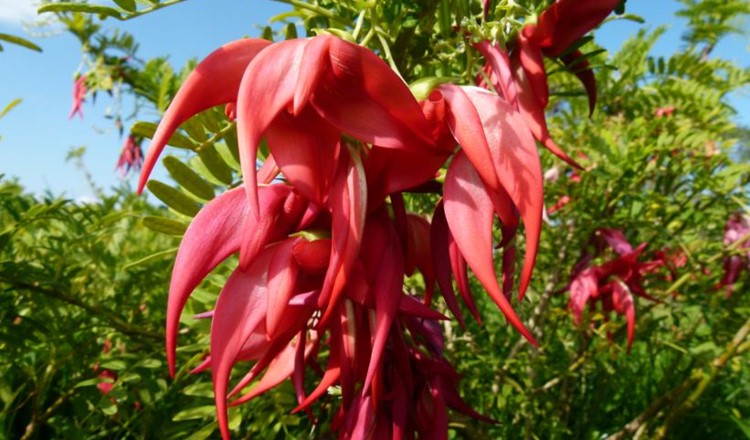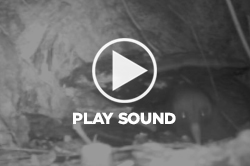
July 2023 Newsletter
There were 3 volunteer trips Motuihe during July,2 monitoring trips and 1 planting trip involving 41 public volunteers, 32 Motuihe leaders and 149 trees were planted.
  |

A second photo sent to the Trust by a Navy photographer. The pioneer planting is complete and future planting will be final succession plants and rare and endangered plants. This is an amazing achievement by the hundreds of volunteers considering it was a sheep and beef farm 20 years ago.
A big win for threatened plants on Motuihe
We are delighted to announce that the Motuihe Trust has been awarded a grant from DoC’s Community Fund to work on a three year project to help with the recovery of threatened native plants. This will involve more work to grow our wonderful kākābeak and better understand the conditions they need to naturally regenerate. We will also be collecting seed to translocate another 21 threatened plant species onto Motuihe, including Cook’s scurvey grass, a native hibiscus and geranium, mistletoes and rātā.
This will be a huge boost to the work the Motuihe Trust is doing to increase the native diversity on Motuihe and help with our advocacy for threatened species. Adding a new location to where these threatened species are growing (especially one that is pest-free) helps increase their chances of long-term survival. We hope that this will be the beginning of Motuihe as a space the public can visit to experience, and learn to love, a range of rare and special native plants.
Bella Burgess
Scandia rosifolia seedlings. This plant is listed as Nationally Critical.
Photo from Shelley Heiss-Dunlop
Volunteers wanted to help with bird monitoring
This spring we are beginning bird monitoring and we would love your help! Bird monitoring helps us better measure how well the different bird species on Motuihe are doing and how they are using (or avoiding) different areas of the island. We will be doing this with 5 minute bird counts, which involve counting all the different birds you see or hear over 5 minutes at a particular monitoring point. Email bella.burgess@gmail.com to sign up or find out more. Enthusiasm, decent listening skills and an eagerness to learn is all you need. Training and resources to help identify different birds will be provided.
Bella Burgess
Fun Fungi of the month
Wood ear mushrooms – hakeke – Auricularia novozealandica: The walls might not have ears, but our trees sometimes do! You may have spotted this mushroom on Motuihe growing on dead trees along the Tieke Track. Wood ear mushrooms are a common fungi that can be found all over New Zealand. They play an important part in our forest ecosystems by breaking down dead wood tissue into nutrients that other organisms can use. You will often see them on dead mahoe branches, but they are not fussy and will happily help decompose most woody plants once they die. Unlike many other mushrooms, wood ear fungi are able to completely dry out and then rehydrate back to full form in wet conditions. Wood ear fungi are edible and are a particularly popular ingredient in China (where they have a very closely related species). Between 1870 – 1950 wood ear fungi were a major export from New Zealand and earned the nickname ‘Taranaki wool’ when many tonnes were collected and sent overseas as forest was being cleared around Taranaki. Nowadays New Zealand imports more wood ear mushrooms than it sends overseas, but we still grow some for local fungi enthusiasts.
Bella Burgess Photo credit Dan FP on iNaturalist
Impressive growth on Motuihe
Through the last eight months of not so good weather the flora on Motuihe has not been resting. Look at these magnificent canopy specimens. Trees grown from seed gathered here on the island. Will they themselves seed next year?
Phil Francis
Kakabeak near Calypso Bay
Rewarewa
Totara
Addition to our website
Steve Nelson sent me a personal recollection by James la Roche about a trip from England to New Zealand in a sailing ship and ending up in quarantine at Motuihe. While adding this link I also added a picture of the unmarked graves DoC recently discovered and the list of burials on the island from the 1870s and 1880s. https://www.motuihe.org.nz/about-the-island/heritage/1872-1918-quarantine-stations/ Then scroll down to the bottom of this page for the recent additions.
TRIP REPORTS
Dreamweaver Wednesday 19 July
Midwinter trips always run the risk of the weather intervening; groups from Downer (Central Rail Link) and WSP, totalling 41, got it spot on as it turned into a lovely day for planting and weeding. Phil, Jill, Dina and Simon came over on the Dreamweaver with John, Lois, Jill S and Fiona on Graeme’s boat. Colin was benched at the last minute not making it through the prematch warm up.
Phil supervised a nursery group and at the same time worked on the irrigation system installing a new tap in the toilet to prevent flooding. The planting group managed to plant 149 plants in a very inaccessible area above Snapper Bay. The species included Kahikatea, Puriri and Coastal Mahoe so plenty of canopy trees going in.
Graeme and Simon took a team and cleared weeds on the right side off the Calypso track, up to the pond and clearing the open ‘paddock’ beyond of juvenile woolies. A small dedicated team found a pod infested area just above the Tieke track entrance. Good to have a couple bags of pods to show for the effort. Lois carried out a number of track jobs.
Our visitors enjoyed a lovely afternoon with plenty braving the Dreamweaver bow on the way home - that after a bracing dip at the barge ramp to jump into the tender. Everyone made it back to pier Z safe and sound.
Simon Sheen/Phil Francis

Downer and WSP volunteers after a good day's work (photo Lois Badham)
Motuihe Kiwi Call Count Survey weekends 2023
May 27, July 15 and 22
Team: Helen Bucksey, Bella Burgess, Cage Cardon, Chris Challinor, Emma Dunning, Martin Draffin, Linzi Edwards, Cleone Guy, Jeremy Hay, Genevieve Herbison, Talia Hochwimmer, Indi Mallinder, Alex Mazonowics, Nate Mckenzie, Millar Mercer, Neisha Oikawa, Jacqui Oldham, Jackie Rutherford, Emma Salmon, Joce Service, Jill Souflott, Julie Thomson, Ian Westwood, Tyson Williams
Survey:
Our enthusiastic and talented team was frustrated by the relentless wind and rain which cancelled our plans for April and June. Jeremy patiently brewed his lovely mulled wine for a third time prior to our successful night on July 15 when his brew was much appreciated after two hours of bone-chill at 7 different listening sites.
Results: (Compared to last year.)
| Survey Year | Night 1 | Night 2 | Night 3 | Night 4 |
| 2022 Total calls /2 hours Ratio of male : female calls |
May 7 24 1 : 1 |
June 4 30 6.5 : 1 |
June 25 17 2.4 : 1 |
July 2 39 2 : 1 |
| 2023 Total calls/2 hours Ratio of male : female calls |
May 27 33 2 : 1 |
Weather Cancelled |
July 15 20 3 : 1 |
July 22 25 4 : 1 |
The un-expected non-vocal sites observed on July 15 led our team to check cameras nearby. These revealed the presence of the usual suspects but they were seemingly further into the breeding cycle than usual. Check the links below for a fat female exhibiting difficulty getting into and out of a burrow.
https://drive.google.com/file/d/1flcX2i4wKv5E-bPDh90LYUI7TA8Pwecz/view?usp=sharing
https://drive.google.com/file/d/1DTAv3HKwcqk0PNR-Pf4-E6OTd9tCDNtj/view?usp=sharing
https://drive.google.com/file/d/1xsPE1g1g-TG9uW5taEbBS1w7Ce-GCngO/view?usp=sharing
https://drive.google.com/file/d/1IJ0daNsQISt1exnpgk5xznmbzBrbUHFJ/view?usp=sharing
Cage has been working hard to develop Motuihe maps using the app “ArcGIS Field Maps” for us to use for locating all our monitoring stations and recording our data in the field. Our teams have found this very easy to use in our trials on both the July listening nights. We also made the most of the hours we had on Motuihe: clearing culverts and dealing to moth plant pods in Tieke track, weed work south of Tieke track, camera grid work, sheer-water project work, gecko grid work, seed collecting, nursery work, fungi photography for Bella’s iNaturalist fungi project and for our new recruits, learning how to find our listening sites in the dark.
Julie Thomson
Highlights:
- Jeremy’s best ever antidote for bone-chill
- Jackie’s carrot cake
- Tyson-led spot-lighting in Disaster Gully between 10 and 11pm. Spotting 7 wētāpunga resting on puriri or pohutukawa trunks. Similar encounters with resting puriri moths.
- Sharing a divine orange and almond cake made by renowned chef and forager, Nate McKenzie.
- Getting to know our new Ranger, Emma, who joined our team on July 15
- For Indi, Gen, Neisha and Jill, a day-time encounter with a LSK at it’s burrow entry

Puriri Moth photo from Tyson Williams
Spotlighting team photo from Bella Burgess
Female Wetapunga photo from Chris Challinor





